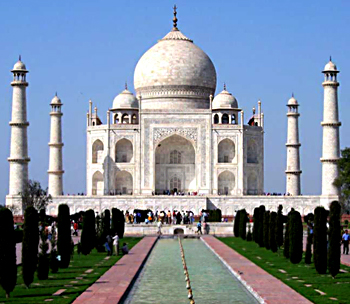 Agra is located in the northern part of Uttar Pradesh and has a mythological past as its name is mentioned in the Mahabharata as Agrevana. Agra at present is a famous tourist destination and the architecture of the place encompasses mostly Islamic style of architecture. The major architectural creations of Agra are the Agra fort and the Taj Mahal on the bank of river Yamuna. The Mughal Garden architecture is also an important structural design of Agra. Along with Sikandra and Fatehpur-Sikri, Agra was the region where the epit¬ome of Islamic architecture blossomed.
Agra is located in the northern part of Uttar Pradesh and has a mythological past as its name is mentioned in the Mahabharata as Agrevana. Agra at present is a famous tourist destination and the architecture of the place encompasses mostly Islamic style of architecture. The major architectural creations of Agra are the Agra fort and the Taj Mahal on the bank of river Yamuna. The Mughal Garden architecture is also an important structural design of Agra. Along with Sikandra and Fatehpur-Sikri, Agra was the region where the epit¬ome of Islamic architecture blossomed.
The most important fort built during the Mughal era is the Agra Fort constructed by Akbar. There is a mosque inside the fort which is known as the Moti Masjid. It is built of marble and is the crown of Mughal architecture. Shah Jahan`s living room has a square garden, known as the Anguri bagh. It has flowerbeds, waterways and fountains. Jahangir`s palace, the most noteworthy building in the Agra fort and the golden pavilion are perfect examples of the synergy of Hindu and Muslim architecture. The curved roof structure incorporated in the architecture of the Islamic palace buildings is influenced from the traditional design of Bengal. The Itimad-ud-Daula tomb has a geometric shape and is placed in a square garden. The central hall where the grave is located is divided into nine parts and there are steps in the corner leading to the four minarets. Stone decorations start from the spindle on the roof of the central hall and are symmetrically placed throughout the building. The white marble mausoleum is decorated with coloured stones.
The Mughal construction of tombs starting with tomb of Humayun, reached its zenith with the architectural pattern of Taj Mahal. Its uniqueness is that it is placed at one end of a square garden. The Taj Mahal is one of the Seven Wonders of the World. The Yamuna River flows in the background and the square garden is in front of this white marble monument. The perfection of its proportions and a high standard of craftsmanship, have made people look upon this building with awe. The architecture of the Ram Bagh garden of Agra is of geometrical Islamic style. The Jami Masjid Friday mosque built by Shah Jahan has low domes and not very tall minarets. The Mughal Sheraton hotel is a post independent structure and the stone buildings of these kind is built in a style of architecture that is commonly seen in Agra. The red brick that is used resembles the red sandstones. The courtyard of the building is constructed in the pattern of a Mughal garden.
Built on the banks of river Yamuna, the medieval city of Agra is noted for its architectural extravaganza. It is a major crowd puller because of the majestic building of the Mughal era. The Taj Mahal and the Agra fort have been declared as UNESCO World Heritage sites.



















